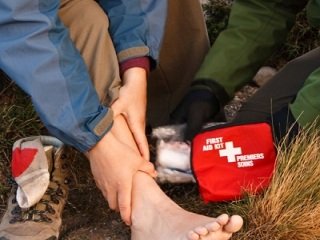 In my last article, I provided some examples on how to prevent several of the common injuries associated with the outdoors from happening. However, we can’t predict the future, or change the fact that accidents happen, and sometimes we find ourselves in dangerous situations. This brings me to the second part in my Backcountry First Aid series, in which I’ll describe what to do in an emergency.
In my last article, I provided some examples on how to prevent several of the common injuries associated with the outdoors from happening. However, we can’t predict the future, or change the fact that accidents happen, and sometimes we find ourselves in dangerous situations. This brings me to the second part in my Backcountry First Aid series, in which I’ll describe what to do in an emergency.
In the case of an accident, such as an injury, maintaining a level head and even assigning a group leader to act as the decision-maker in such a situation is important. Establishing someone as a leader will help prevent any unnecessary arguments that will waste time and may cost the injured person severely. If someone is injured due to an accident, everyone should immediately move away from the site of the accident, to make sure no one else is hurt. Then, you’ll need to assess the injury and apply first aid after making sure the injured individual can breathe properly, especially if unconscious. If conscious, be sure to offer continual reassurance and maintain communication during the first aid application. This will help calm them down and keep them focused on you, not the injury. Next, you’ll need to keep the individual warm and try to keep them from moving around too much, in order to prevent aggravating their injury.
Depending on the extent of the injury and your location in relation to professional medical aid, you’ll need to decide if it’s safe to move the injured person, call for medical evacuation, or send one or more people in your group to retrieve help. Your decision here will depend on your location, the terrain, the time of day, weather, and the extent of the injuries.
Speaking of weather, any outdoorsman can attest to the unpredictability of the weather and that it can wreak havoc on your plans during a camping or hiking trip, especially when it’s severe. Sometimes, severe weather forces us to seek shelter or remain confined to a safe location until it passes or until help finds us.
Everyone wants to be a hero or be the one who makes the decisions, but knowing your limits can keep everyone safe in an emergency situation. Do as much as you safely can for any injured person, and then make seeking medical attention your top priority. The most important thing you can do for your group in an outdoor emergency is to refrain from panicking. This will help you remain calm, but will also help soothe the potentially panicked moods of your companions, which can mean all the difference in such a situation. Also, always be sure to not only have a first aid kit, but one designed for the duration of your trip, as well as the number of people you’ll be travelling with.








